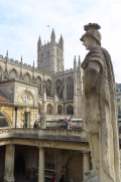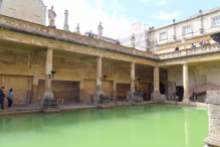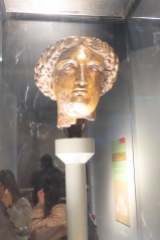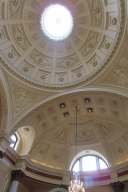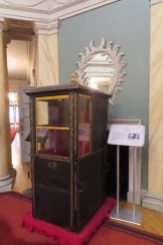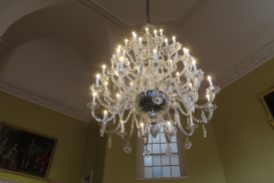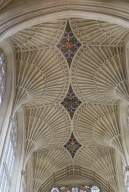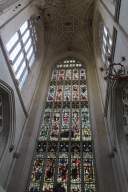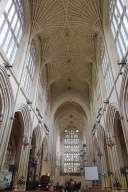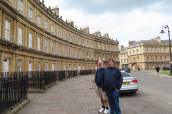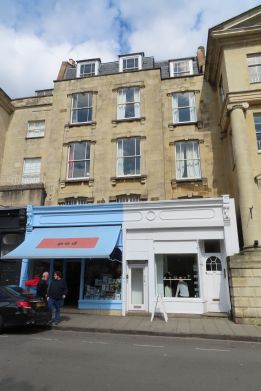Philip Champion de Crespigny (1738 – 1803) was my fifth great grandfather (5*great).
Philip was the fifth of seven children of Philip (1704-1765) and his wife Anne née Fonnereau. He was born on 1 April at his father’s house at Doctors Commons in London. He was christened on 11 April at St Benets, Pauls Wharf. Philip senior was Marshall of the Court of Admiralty and Secretary of the French Hospital.
In 1741 the family moved to Denmark Hill, Camberwell where Philip senior had taken a lease of a house and sixteen acres.
Philip’s older brother Claude (1734 – 1818) was educated at Eton and it is likely that Philip was also. (http://www.historyofparliamentonline.org/volume/1754-1790/member/crespigny-philip-champion-1803 )
A proctor was a legal practitioner in the ecclesiastical and admiralty courts. A King’s Proctor acted in all causes concerning the King.
(http://en.wikipedia.org/wiki/Proctor) Doctors’ Commons, also called the College of Civilians, was a society of lawyers practising civil law in London. The proctors, who were also associated with Doctors’ Commons, were like present-day common law solicitors.
(http://en.wikipedia.org/wiki/Doctors%27_Commons)
Marriages and children
Philip married four times. On 24 November 1762 Philip married
Sarah Cocksedge in Norfolk. They
married by licence; this licence was issued on 11 November. Sarah and Philip had four children:
- Thomas (1763 1799)
- Philip (1765 – 1851)
- Jane (1766 – 1785)
- Anne (1768 – 1844)
Philip’s second marriage was to Betsy Hodges in about 1771. Betsy was the widow of George Borradale whom she had married in 1765 (Parish Records Collection – marriage 1765 Hodges Borradale) Philip and Betsy had one son, Charles (1772 – 1774) who was christened 1 June 1772 in St Giles, Camberwell, and buried 21 October 1774 in the Church of St Albans. Betsy died in 1772, probably not long after giving birth to her son. She was buried at St Marylebone on 22 May 1772.
Philip’s third marriage was to Clarissa, daughter of James Brook of Rathbone Place. They married on 1 July 1774 at St Marylebone by licence with the consent of her father. She was a minor, of the parish of St Marylebone. Philip was recorded as an Esquire of Walton upon Thames, County of Surry, widower. He signed his name PC Crespigny. The witnesses were James Brooke and Hester Brooke.
Clarissa and Philip had four children:
Clarissa and her children were painted in 1780 by George Romney. Romney’s diary notes that the painting was oval and he charged fifty pounds. In 1780 Horace Walpole apparently noted George Romney’s “rise to fashion”. (http://www.npg.org.uk/whatson/exhibitions/2002/george-romney/biography.php)
 |
| Clarissa Champion de Crespigny and her children by George Romney. The painting was last sold in 1986 from a private seller to a private buyer through the London dealers Leger Galleries. This image is from a reproduction of the painting and came from Alex Kidson, Research Fellow of the Romney Society. |
Clarissa died in 1782 and was buried at St Marylebone on 22 May. She was about twenty-seven years old. A short biographical piece about her father refers to her as an amiable and accomplished lady who died in the prime of her life.
Philip’s fourth marriage was in 1783 to Dorothy Scott (1765 – 1837), daughter of Richard Scott of Betton Strange Hall near Shrewsbury. (London Magazine vol 52 pg 103 1783)
Jonathan Scott (1754 – 1829), one of Dorothy’s brothers, was an early translator of what was then called ‘The Arabian Nights Entertainment’, better known now as ‘The 1001 Nights’. (http://shrewsburylocalhistory.org.uk/scott.htm)
Dorothy and Philip had four children
- George (1783 – 1813) killed in Spain
- Eliza (1784 – 1831) who married the first Lord Vivian having eloped to Gretna Green (Ancestry.com. Gretna Green, Scotland, Marriage Registers, 1794-1895 [database on-line].)
- Charles Fox (1785 – 1875) my fourth great grandfather
- Dorothea (1800 – 1800) born and died in Bath (I am not sure where I have the information for this child, I am unable to find any records associated with her and it seems surprising that she was born so many years after her siblings, though her mother did have a child after 1804 following her second marriage).
After Philip’s death Dorothy married again to Sir John Keane (1757 – 1829) and had a son, George Michael Keane.
Dorothy’s portrait was painted by George Romney in 1790 with Romney’s diary noting “1790 Wed 17 March Mrs Chrspaney at 1/2 pt 2”. He charge forty-two pounds for the oil on canvas. Dorothy’s great grandson George Harrison Champion de Crespigny (1863 – 1945) sold the painting through Christies on 27 April 1901 for ₤5,880-00. (“HIGH PRICES FOR PICTURES AND ENGRAVINGS.” Otago Witness 3 July 1901: 75. Papers Past — Otago Witness. National Library of New Zealand. Web. 27 Jan. 2014. <http://paperspast.natlib.govt.nz/cgi-bin/paperspast?a=d&d=OW19010703.2.234.1>) The painting is now in the John Howard McFadden Collection of the Philadelphia Museum of Art. (http://www.philamuseum.org/collections/permanent/103821.html)
Parliamentary career
In 1774 Crespigny was returned on the Fonnereau interest at Sudbury after a contest, but lost his seat on petition. (Drummond, Mary M. “CRESPIGNY, Philip Champion (d.1803), of Burwood, Nr. Cobham, Surr.” The History of Parliament: The House of Commons 1754-1790, 1964. Member Biographies from The History of Parliament Online. Web. 28 Jan. 2014. <http://www.historyofparliamentonline.org/volume/1754-1790/member/crespigny-philip-champion-1803>.)
Philip’s mother was the daughter of Claude Fonnereau, a wealthy merchant. Her brother,and thus Philip’s uncle, Thomas Fonnereau (1699 – 1779) was returned for Sudbury in 1741 and sat for that consituency until 1768. Several of those years were in conjunction with Thomas Walpole who was a business connection. Thomas later sat for Aldeburgh from 1773 until his death in 1779. (Namier, Sir Lewis. “FONNEREAU, Thomas (1699-1779), of Ipswich, Suff.” The History of Parliament: The House of Commons 1754-1790, 1964. Web. 28 Jan. 2014. <http://www.historyofparliamentonline.org/volume/1754-1790/member/fonnereau-thomas-1699-1779>.) (Thomas Fonnereau. (2013, December 23). In Wikipedia, The Free Encyclopedia. Retrieved 01:03, January 28, 2014, from http://en.wikipedia.org/w/index.php?title=Thomas_Fonnereau&oldid=587412088)
In 1780 Philip was returned unopposed at Aldeburgh on the Fonnereau interest, and at Sudbury after a contest. He held both seats until 1781 when he lost Sudbury on petition, and continued to sit for Aldeburgh until 1790.
Only one speech is recorded from Philip when he spoke in 1781 against the bill for excluding contractors from the House of Commons.
 |
| Extract from the debate in the House of Commons (Debrett, ii. 296.) retrieved from Great Britain. Parliament. House of Commons. The Parliamentary Register: Or, History of the Proceedings and Debates of the House of Commons. Vol. 2. page 296.: J. Debrett, 1781. Google Books. 2007. Web. 28 Jan. 2014. <http://books.google.com.au/books?id=1-kMAAAAYAAJ>.
|
The exclusion of contractors from the House of Commons was first introduced in 1779 and was part of political reform receiving an impetus from the American Revolution. The bill finally passed at the end of 1782 and it placed on the exclusion list anybody who had a contract with the treasury, the navy, the victualling office, the master-general, or the board of ordinance, … Before this reform, “the fact that a man had a contract with the Government laid him under the necessity of receiving orders from the Treasury as to his political conduct.” George III was said to turn all government expenditures to political account and “maintained a corps of subservient members in the House of Commons”. Vast sums were disbursed to contractors for the navy and army between 1770 and 1782 which some asserted were an abuse of the contract process and designed to buy political support. (Porritt, Edward. The Unreformed House of Commons. : Cambridge UP, 1963. Google Books. CUP Archive. Web. 29 Jan. 2014. <books.google.com.au/books?id=57c8AAAAIAAJ&pg=PA219>. pages 219-220)
Philip supported the administration of Lord North who was prime-minister from 1770-1782 and who later served in a coalition, the Fox-North coalition, with Charles James Fox in 1783. Philip named his youngest son, Charles James Fox Champion de crespigny, after Charles James Fox.
Houses
Philip died in his house at 5 Portland Place, Bath. The house is one of ten symmetrical terrace houses built in 1786 by John Eveleigh. Number 5 is the largest house in the terrace and was built for P. C. Crespigny.
 |
| Portland Place, Bath image from Google street view http://goo.gl/maps/seYvj. Number 5 is the house centred on the triangular pediment. It has five windows across and a central front door. Its neighbours’ front doors are aligned either to the left or the right. To the front of the house is a ramp which was provided for easier access by sedan chairs. |
The house together with number 4 was converted into a school from 1875 until 1994. In 1994 both houses were converted to flats. The house, together with its neighbours, is Grade II heritage listed. (“List Entry: 1-10, PORTLAND PLACE.” National Heritage Protection Plan. English Heritage, 15 Oct. 2010. Web. 29 Jan. 2014. <http://list.english-heritage.org.uk/resultsingle.aspx?uid=1394403>.)
Philip de Crespigny leased Hintleham Hall near Ipswich in Suffolk. His children George, Eliza, and Charles were born there between 1783 and 1785. In 1785 his daughter Jane died at Hintlesham Hall. At that time Hintlesham Hall was owned by Richard Lloyd, a political lawyer who became Solicitor-General.(http://www.hintleshamhall.co.uk/history.html)
In 1794 Philip de Crespigny bought Talyllyn House and the Manor of Llangasty Talyllyn in Breconshire together with 2000 acres for £1600. In the advertisement for the sale the house was described as “a good old stone built and slated Mansion House… to which the present Proprietor meant to have added a regular Building” While owned by the de Crespignys, the house and outbuildings were extensively remodelled. From 1810 the estate was leased as a farm. It was sold in 1838 by Philip’s son Charles Fox de Crespigny. Philip and his son Charles both served as High Sheriff of Brecknockshire or Breconshire, Philip in 1796 and Charles in 1812. The house was destroyed in the nineteenth century. (“History of the Farm.” Tŷ-Mawr. Tŷ-Mawr Lime Ltd, n.d. Web. 29 Jan. 2014. <http://www.lime.org.uk/history-of-the-farm/>.)
Other land purchases by Philip include Creeting All Saints in Surrey bought from the Bridgeman family. (http://forebears.co.uk/england/suffolk/creeting-st-olave)
Freemason
Philip was a Freemason. In 1781 he was Grand Steward for Somerset House Lodge. (http://www.phoenixmasonry.org/prestonian_lectures_volume_3.htm)














